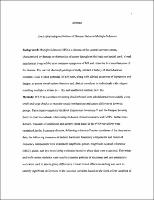Please use this identifier to cite or link to this item:
https://hdl.handle.net/20.500.12202/7152| Title: | Electrophysiological indices of disease status in multiple sclerosis |
| Authors: | Zemon, Vance Foley, Frederick Gordon, James Butler, Pamela Siegel, Kasey B. |
| Keywords: | neurosciences psychobiology physiological psychology |
| Issue Date: | 2019 |
| Citation: | Siegel, K. B. (2019). Electrophysiological indices of disease status in multiple sclerosis (Publication No. 27794087) [Doctoral dissertation, Yeshiva University]. ProQuest Dissertations & Theses Global; Publicly Available Content Database. (2352670110). |
| Series/Report no.: | ProQuest Dissertations Open;PQ document 2352670110 |
| Abstract: | Background: Multiple Sclerosis (MS) is a disease of the central nervous system, characterized by damage or destruction of axons throughout the brain and spinal cord. Visual impairment is one of the most common symptoms of MS and often the first manifestation of the disease. The current electrophysiological study utilized a battery of short-duration transient visual evoked potential (tVEP) tests, along with clinical measures of depression and fatigue, to assess visual system function and clinical correlates in individuals with relapse-remitting multiple sclerosis (n = 18), and unaffected controls (n = 16). Methods: tVEPs to a contrast-reversing checkerboard were administered monocularly using small and large checks to examine neural mechanisms and assess differences between groups. Participants completed the Beck Depression Inventory-II and the Fatigue Severity Scale in order to evaluate relationships between clinical measures and tVEPs. In the time-domain, measures of amplitude and latency (peak time) in the tVEP waveform were examined. In the frequency-domain, following a discrete Fourier transform of the time-series data, the following measures of distinct harmonic frequency components and bands of frequency components were examined: amplitude, power, magnitude-squared coherence (MSC), phase, and two novel delay estimates based on phase data were examined. Univariate and multivariate statistics were used to examine patterns of responses and non-parametric tests were used to assess group differences. Linear mixed effects modelling was used to group, eye (right vs. left fellow eyes), and stimulus condition (large vs. small checks). Classification accuracy was assessed for all measures using receiver operating characteristic (ROC) curve analysis and the non-parametric measures of area under the ROC curve (AUC) and A'. Results: Overall, small checks yielded stronger responses and more significant results than did large checks. There was great variability in amplitude within and between groups. There were significant differences in P60-N75 amplitude and mean MSC for Frequency Band 3 (30-40 Hz) between groups (right eye: p = .02, left eye: p = .01). There were numerous group differences in the time and frequency-domain delay measures. The frequency-domain measures produced the strongest effects and had the greatest classification accuracy for group membership (H24 delay: p < .01, Band 2 delay: p = .01). Conclusions: The current study findings support the use of the short-duration tVEP-CR test (Zemon & Gordon, 2018) in the assessment of visual dysfunction in patients with MS. Results support increased latency as a characteristic finding in MS and add to existing literature by providing evidence for the use of novel frequency domain measures, which provide greater classification accuracy and are more sensitive to detecting differences between groups than are time-domain measures. These techniques require further study using larger samples as they have the potential to be used as biomarkers for this disease. Findings that early excitatory input into the cortex is impacted in MS indicate that neural damage (likely associated with demyelination) is occurring in early, precortical levels of visual processing. Notably, the P60 time point is often missed and not evaluated in clinics. Additionally, these findings potentially provide evidence to support the utility of VEPs in the diagnosis, symptom progression, and treatment monitoring of individuals with MS. |
| Description: | Doctoral dissertation / Open Access |
| URI: | https://www.proquest.com/docview/2352670110/587B7B0675604180PQ/1 https://hdl.handle.net/20.500.12202/7152 |
| ISBN: | 9781392734346 |
| Appears in Collections: | Ferkauf Graduate School of Psychology: Doctoral Dissertations |
Files in This Item:
| File | Description | Size | Format | |
|---|---|---|---|---|
| Siegel 2019 Open Electrophysiological_Indices_o.pdf | 10.02 MB | Adobe PDF |  View/Open |
This item is licensed under a Creative Commons License

